SEPTEMBER 2022
This month’s bird and wildlife photography article is about images where at least one subject is in focus and one or more is out of focus. It features images taken from the Whooping Crane blinds during our March 2022 workshop there.

We had some dark, rainy weather on the workshop but we were fortunate to have both Whooping and Sandhill Cranes near the blinds at the same time last spring. Here’s a shot of an adult Whooping Crane with some Lesser Sandhill Cranes in the background out of focus. I think this one works pretty well with the front Whooping Crane in sharp focus and the Sandhills out of focus but recognizable in the background. I think ideally the Sandhill on the right behind the Whooper wouldn’t be there but it’s not an image killer. The techs for this shot were Canon R5, 800RF11 lens, 1/1250 at F11, iso 1600, Av mode, evaluative metering -1.0, handheld. With the 800F11 I was barely able to fit the Whooper in, I think ideally I would have had a bit more space around it.
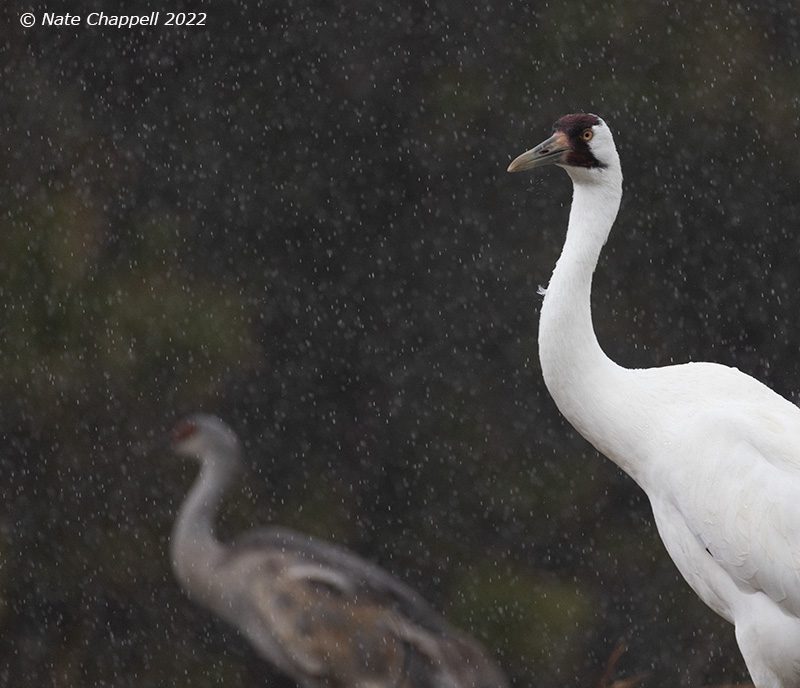
Here’s more of a closeup, it’s kind of an unconventional crop but I think it works pretty well. Again, the front bird being in focus and in this case also looking into the photo adds strength to it. It also gives some indication of the size difference of the two species. The techs for this shot were the same as the last, Canon R5, 800RF11 lens, 1/1250 at F11, iso 1600, Av mode, evaluative metering -1.0, handheld. I was dialing in a fair bit of negative exposure compensation to hold the whites against that dark background. I like both this and the top image, but prefer this one.
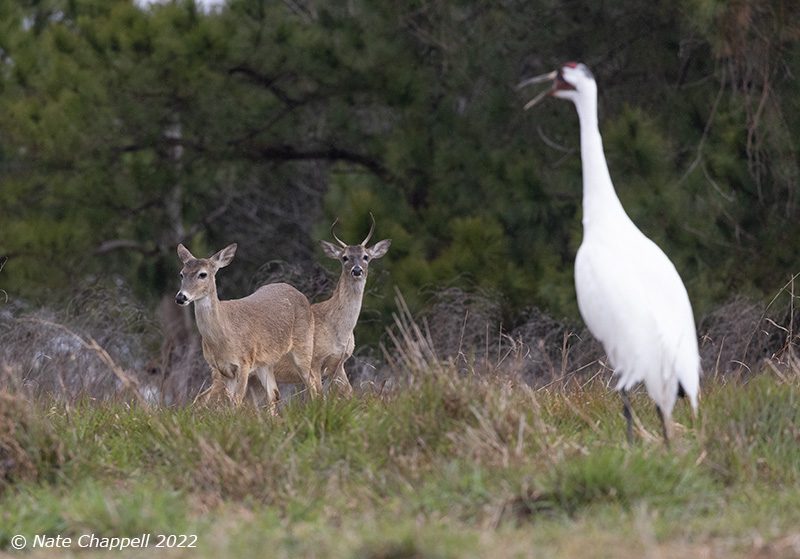
We were fortunate also to have a fair number of White-tailed Deer show up at the blind at the same time as the Whooping Cranes. In this shot I have focused on the young White-tails, rendering the Whooping Crane which is calling at them out of focus. While I think this was potentially a very interesting shot, I don’t think it works all that well, mainly because the Whooping Crane is in the foreground and out of focus. I think it would have been better in this case to focus on the crane and render the deer out of focus or try to stop down a lot, focusing on the crane and trying to get the deer in reasonable focus. The techs for this shot were Canon R5, 100-400mm at 400mm, 1/1600 F8, iso 2000, Av mode, evaluative metering at 0, handheld. For this shot I didn’t need as much negative exposure compensation as I had some brighter foreground to balance the exposure, although the shot did turn out brighter overall that the last two. I was using a fairly fast shutter speed as I often do in case there was action.

Here’s another shot with the same settings as the previous one, although the action isn’t as good I prefer this one as the front subject is in focus and the back one out of focus but recognizable. The techs for this shot were Canon R5, 100-400mm at 312mm, 1/1600 F8, iso 2000, Av mode, evaluative metering at 0, handheld.

Here’s one more with both Deer and Whooping Crane in the shot. Of the three, this is my favorite image as the White-tail is quite close and making good eye contact with us and the crane although out of focus is recognizable and has an interesting pose, the two subjects balance each other in the composition. The techs for this shot were Canon R5, 100-400mm at 321mm, 1/1250 F8, iso 2000, Av mode, evaluative metering at 0, handheld.

In addition to the Sandhill Cranes and White-tailed Deer, there are usually Grackles, Rock Doves and Black-bellied Whistling Ducks at this location as well. It can make for some interesting interaction shots as the birds compete for the corn which is put out. In this shot one of the Whooping Cranes is having a go at some of the other birds. Although there are out of focus birds in the foreground in this shot, I don’t think they hurt the image much because they are small, but mostly because the action of the crane chasing off the Rock Dove and duck is quite strong. The techs for this shot were Canon R5, 100-400mm at 400mm, 1/2000 F8, iso 1250, Manual Exposure, handheld. At this point it had become quite a bit brighter so I was able to drop down my iso a fair bit.
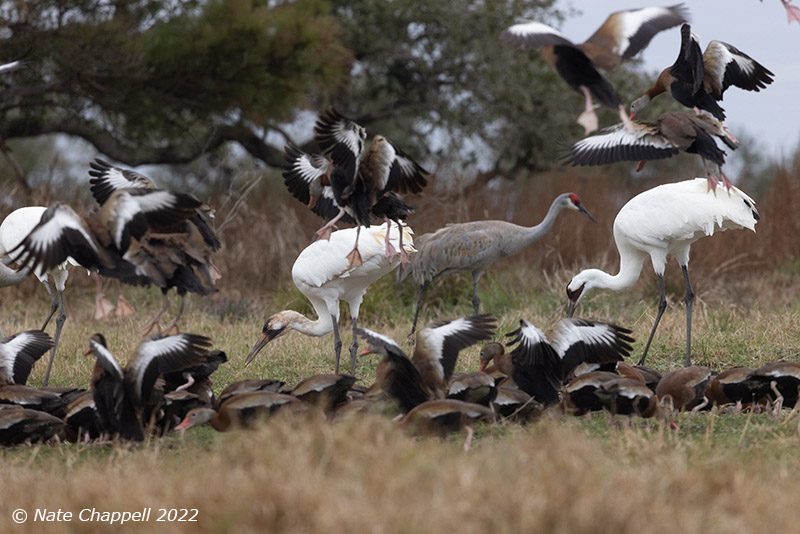
Here’s another shot of the birds feeding, this time a flock of Black-bellied Whistling Ducks were landing in front of feeding Whooping and Sandhill Cranes. While I think it’s interesting to see the different species together in the same frame I feel like this image doesn’t work very well for a couple of reasons. I think the main one is that it’s just too busy, in addition the ducks in the foreground are largely out of focus in front of the in focus cranes in the background. The techs for this shot were Canon R5, 100-400mm at 400mm, 1/2000 F9, iso 1600, Manual Exposure, handheld.
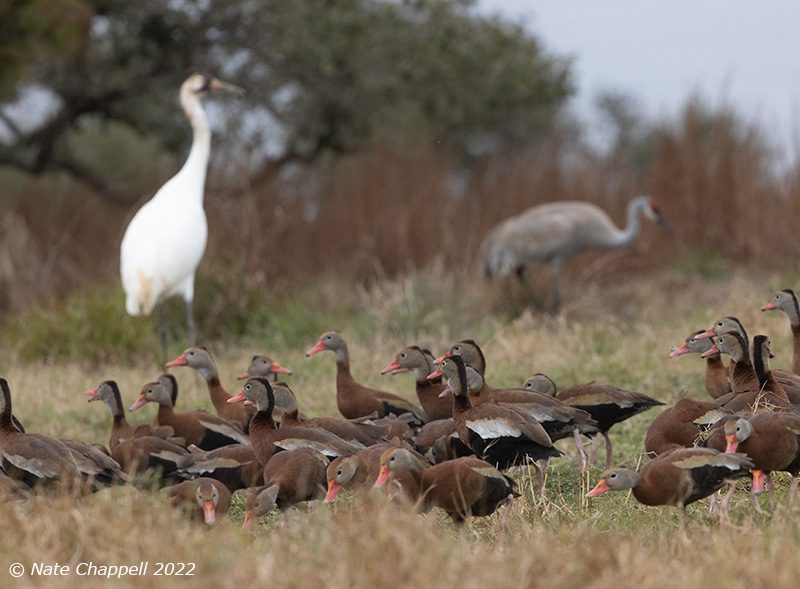
On the other hand, I feel like this image works pretty well. The foreground subject, the ducks are mostly pretty sharp and there is good separation between them and the out of focus background cranes. The techs for this shot were Canon R5, 100-400mm at 400mm, 1/2000 F9, iso 1600, Manual Exposure, handheld.
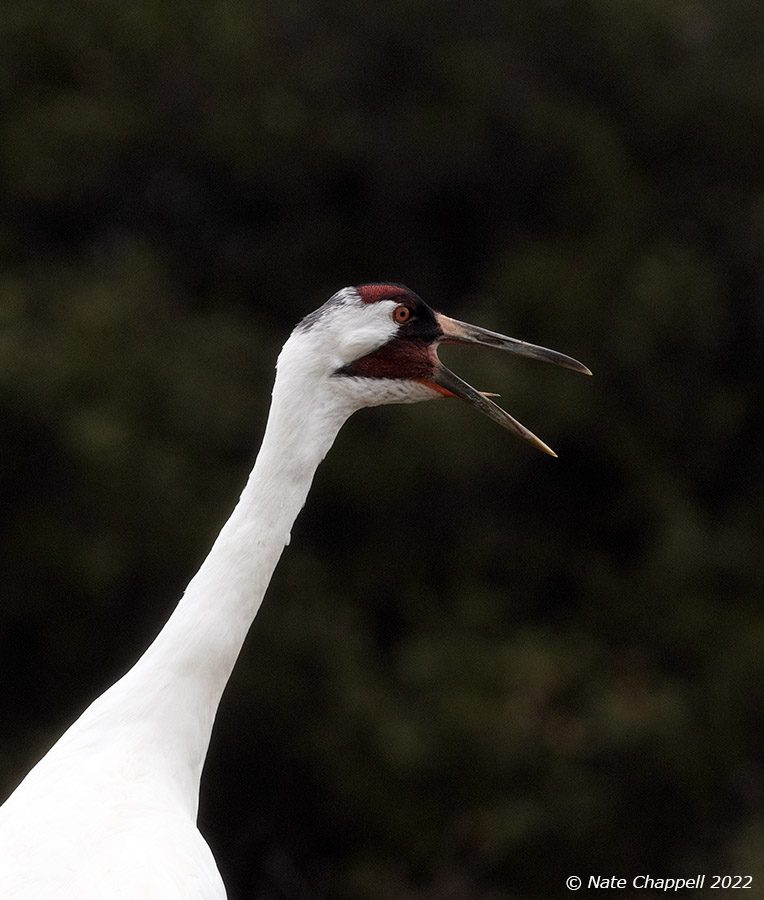
To finish up I thought I would show a couple other images from this location without out of focus subjects also in the frame. This shot of a calling adult Whooping Crane shows you how close the birds sometimes get to the blind. It’s cropped a fair bit but taken with a full frame camera at only 400mm. The techs for this shot were Canon R5, 100-400mm at 400mm, 1/1600 F8, iso 1250, Manual Exposure, handheld.

We usually photograph from this blind in the afternoon with the suns at our back, but I did a bit of morning photography there the last day, the birds were backlit but it created an interesting effect. I had to add a fair bit of contrast in post processing to get this result. The techs for the shot were Canon R5, 800RF11 lens, 1/1000 at F11, iso 3200, Av mode, evaluative metering at 0, handheld.
In conclusion, when photographing multiple subjects and if it’s impossible to get them all in focus, it’s generally better to have the foreground subject in focus and let the background one go out of focus, unless there is compelling action going on in the background.
